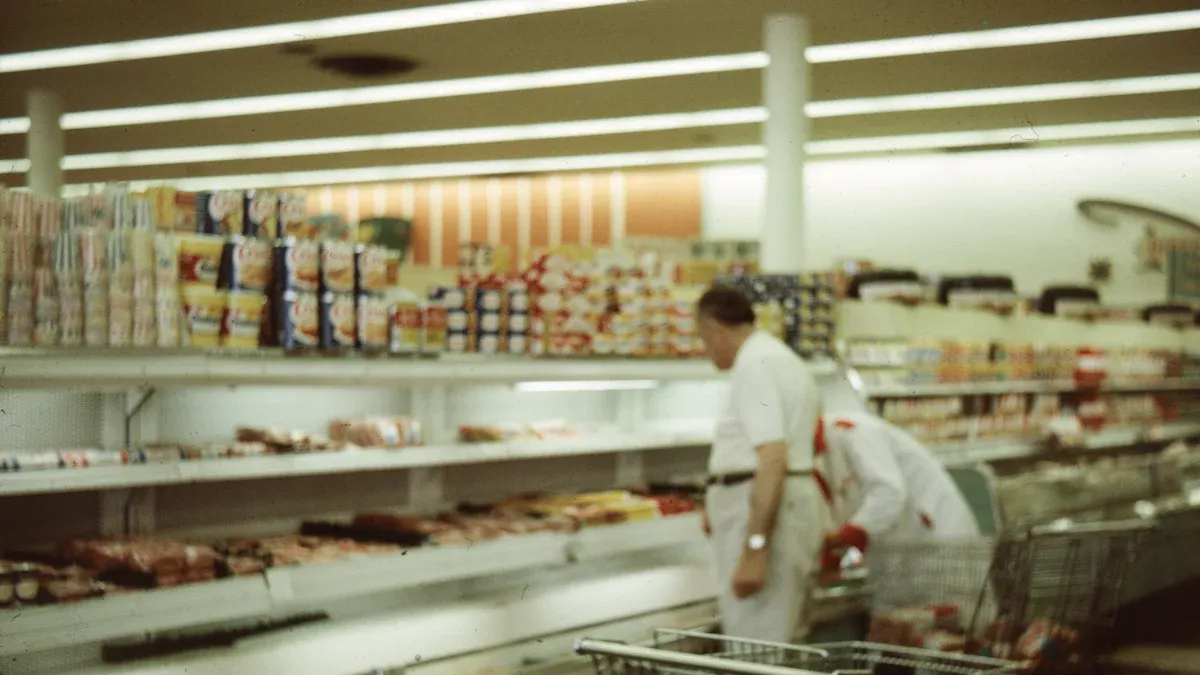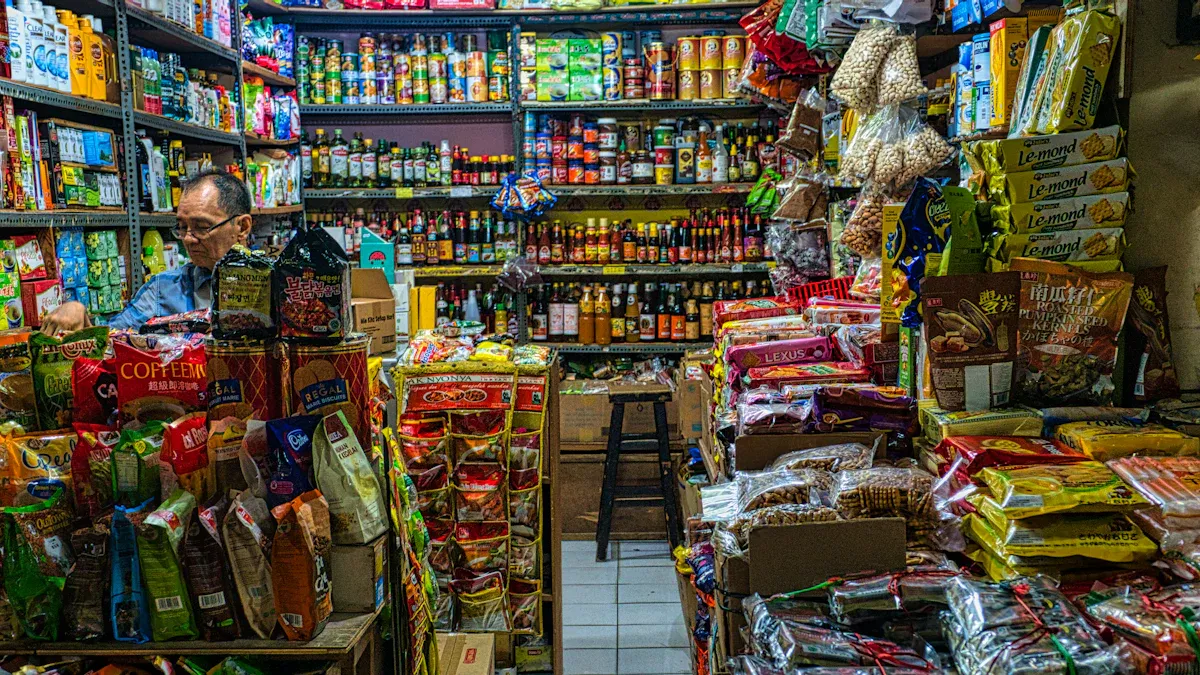The Evolution of Corner Stores: From Local Hubs to Modern Convenience

A shopper once stepped into a corner store filled with local goods, handwritten price tags, and a familiar face behind the counter. Today, c-stores like Speedway or QuikTrip offer digital displays, self-checkout, and a wide range of products. The evolution of corner stores reflects a dramatic shift in the customer experience. Over the last 50 years, the market share of traditional corner stores dropped as c-stores and modern convenience chains grew. In 2025, the United States counted over 152,000 c-stores, showing the transformation in convenience for local communities.
Key Takeaways
Corner stores started as small, family-run shops that served local neighborhoods and became important community gathering places.
Modern convenience stores use technology like self-checkout and digital apps to improve shopping speed and customer experience.
These stores provide easy access to fresh and healthy foods, especially in neighborhoods with few supermarkets.
Corner stores help build social connections and create a sense of safety and belonging in their communities.
Future success depends on balancing new technology with personal service and focusing on local needs and partnerships.
Evolution of Corner Stores

Early Beginnings
The evolution of corner stores began with small, family-owned businesses that served local neighborhoods. Many of these early shops appeared in urban areas where immigrant communities settled. After World War II, Puerto Rican migrants in New York City opened local bodegas to provide familiar foods and goods. These stores helped new arrivals feel at home and offered products that reflected their culture. Local bodegas quickly became more than just places to buy groceries. They acted as gathering spots where neighbors could meet, share news, and support each other.
Urbanist Jane Jacobs described how these small stores kept “eyes on the street.” Their long hours and steady flow of customers made neighborhoods safer and more lively. The presence of a corner store on every block gave people a sense of security and belonging. Over time, the evolution of corner stores included the rise of c-stores like 7-Eleven. These new convenience store chains introduced longer hours and a wider range of products. The shift from traditional corner stores to c-stores marked a new era of accessibility and efficiency.
Community Hubs
Corner stores have always played a key role as community hubs. In Black urban neighborhoods, these stores became important meeting places for people of all ages. Residents often knew the staff by name and trusted them. The corner store marked both physical and social boundaries in neighborhoods shaped by segregation and economic challenges. People gathered there to talk, share stories, and build relationships. Sometimes, these stores even became sites for memorials and community events.
Early corner stores in Black neighborhoods served as intergenerational gathering spots.
They acted as information centers where neighbors exchanged news.
The stores reflected the unique culture and history of each community.
Some people avoided certain stores due to concerns about safety or product quality, showing the complex role these shops played.
The evolution of corner stores also highlights the cultural significance of local bodegas in cities like New York. In neighborhoods such as Bedford-Stuyvesant, local bodegas outnumber supermarkets. These stores provide affordable groceries and act as lifelines for families who cannot travel far. Local bodegas reflect the diversity and resilience of immigrant and working-class communities. Even as neighborhoods change, these stores adapt to new needs and continue to serve as both grocery stores and gathering places.
The evolution of corner stores shows how these businesses moved from community-centered beginnings to modern c-stores. Today, c-stores blend the traditions of local bodegas with new technology and expanded offerings. The story of the corner store is one of adaptation, community, and lasting impact.
Drivers of Change
Technology
Technology has transformed the convenience store industry in many ways. Over the past two decades, c-stores have adopted new tools to improve efficiency and meet customer needs. Self-checkout systems have become common, with a 2024 survey showing that 34% of convenience and fuel retailers now have mature self-checkout networks. Another 37% are testing or expanding these systems. Store owners report that self-checkout improves the customer experience, helps with store layout, and lowers labor costs. Many shoppers, especially younger ones, prefer self-checkout for its speed and control.
C-stores now use digital signage to display promotions and product information. Automation has changed how stores manage inventory, with AI-linked cameras and sensors tracking products in real time. Workers use scheduling apps and task management software to keep operations running smoothly. The COVID-19 pandemic pushed stores to adopt online ordering, curbside pickup, and even robot-assisted operations. New technologies like cloud computing, robotics, and virtual reality continue to shape how c-stores operate and serve their communities.
Technology helps c-stores respond quickly to changing consumer lifestyles and customer needs.
Consumer Trends
Consumer trends have played a major role in shaping c-stores. Shoppers want both value and innovation. They look for affordable products but also seek out new, high-quality items. Many c-stores have become food destinations, offering ready-to-eat meals, fresh produce, and specialty foods. Health-conscious customers now expect to find healthy foods and nutrition-focused options on store shelves. Stores have responded by adding more healthy foods, organic snacks, and global flavors.
People visit multiple stores to find deals and unique products. C-stores have introduced private-label brands and expanded their selection to meet these needs. The demand for better-for-you products shows how important it is for stores to adapt to customer needs. As a result, c-stores now offer a wider range of choices, from traditional snacks to health and wellness items.
Urbanization
Urbanization has changed how c-stores operate and what they offer. In busy cities, people need quick and easy shopping options. C-stores have extended their hours, with many now open 24/7 to fit the schedules of urban customers. Stores have also diversified their products, adding gourmet foods, locally sourced items, and eco-friendly packaging.
Urban c-stores often sit near transport hubs and residential areas, making it easy for people to stop in on the go. These stores focus on essential items and quick purchases, reflecting the fast pace of city life. Many have invested in renovations and digital solutions to improve the shopping experience. Mobile payments, loyalty programs, and self-checkout help busy customers shop faster. C-stores also cater to health-conscious urban shoppers by offering more fresh produce and healthy foods.
Extended hours and strategic locations support urban lifestyles.
Product variety now includes ready-to-eat meals, personal care items, and nutrition-focused choices.
Technology adoption helps c-stores meet the needs of modern city dwellers.
Community Impact of Corner Stores
Accessibility
Corner stores play a vital role in improving access to food in many neighborhoods. In areas where full-service grocery stores are scarce, these stores often serve as the only convenient source for fresh and healthy foods. Many local stores stock fruits like bananas, apples, and oranges. Some even offer more than three types of produce, making healthier choices available to residents. Programs such as the Healthy Corners Program help store owners provide fresh produce at lower prices. This support allows stores to serve over 7,500 healthy snacks each month.
Corner stores fill gaps in food access for underserved communities.
Many stores place fresh produce near cash registers to encourage healthy purchases.
Local owners often know their customers and understand their needs.
Legislative acts and mobile produce initiatives help increase access to affordable foods.
In cities like Chicago and Minneapolis, convenience stores supply fresh fruits and vegetables to neighborhoods that lack supermarkets. These stores are often run by community members who care about their neighbors. Their unique position helps them address food insecurity and meet the needs of diverse populations. By providing essential goods, corner stores help reduce accessibility and affordability concerns for many families.
Social Role
Corner stores have always supported community building and social connection. Local bodegas and small shops act as gathering places where people meet, share stories, and build relationships. In many urban neighborhoods, these stores serve as informal social centers. They help maintain neighborhood strength during times of change and support families during economic hardships.
Corner stores contribute to a sense of belonging and safety by increasing social ties and civic engagement.
City policies in places like Seattle and Louisville now focus on legalizing and revitalizing corner stores as anchors for community life. These stores adapt their services to meet the needs of different groups, such as Native American communities, by offering cooking demonstrations and healthier food options. As customer experiences evolve, corner stores continue to shape the impact on local communities by providing both essential goods and a welcoming space for everyone.
Modern Convenience Store Trends

Product Variety
Modern convenience stores have expanded their product variety to meet changing consumer needs. Shoppers now find more than just snacks and drinks. Many c-stores offer prepared foods, such as large pizzas and made-to-order meals. These options attract people looking for quick, high-quality meals. Beverage choices have also grown. Stores now stock hydration drinks, probiotic sodas, and electrolyte-infused waters. Health and wellness trends drive this change. Customers want nutritious foods, so stores add yogurt parfaits, wraps, premium salads, and fresh fruit cups.
Prepared foods and customizable meals attract more meal occasions.
Beverage innovation includes functional drinks and wellness-focused options.
Health and wellness products, such as organic snacks and nutritious foods, are now common.
C-stores provide high visibility for new products. Their large daily foot traffic helps introduce innovative food and beverage items to a wide audience.
Technology Integration
Technology plays a key role in the modern convenience store. Digital signage and self-service kiosks let customers shop at their own pace. Mobile payment apps make transactions quick and easy. Many c-stores use loyalty programs in their apps and kiosks. These programs offer personalized deals and encourage repeat visits.
Mobile apps allow customers to browse products, order ahead, and schedule pickups or deliveries.
Self-checkout systems and mobile payments reduce wait times and create a faster shopping experience.
Loyalty programs increase basket size and customer retention.
Integration with delivery services expands store reach. These changes improve operational efficiency and enhance the customer experience.
Store Design
Store design trends focus on engaging customers and making shopping easy. Many convenience stores now use digital loyalty programs managed through mobile apps. Programs like 7-Eleven’s 7REWARDS offer exclusive deals and simple enrollment. Contactless payments and self-service kiosks streamline checkout and address staffing challenges.
Partnerships with delivery services, such as Uber and DoorDash, expand accessibility.
Some stores use augmented reality technology to entertain shoppers and create memorable experiences.
AI chatbots provide tailored assistance without adding work for staff.
Advanced security systems, like 360-degree cameras, help keep customers safe.
These features combine technology, in-store tactics, and marketing to create a frictionless, engaging, and loyalty-driven environment in modern convenience stores.
Future of Corner Stores
Challenges
Corner stores face many challenges as they look to the future. The rapid growth of retail technology and changing consumer habits force small retailers to adapt quickly. Many stores must balance adopting new tools like AI and automation with keeping human judgment and personal service. This shift can be hard for stores with limited resources.
Many corner stores struggle to manage business growth and daily tasks with small teams.
Adapting to new technology often means using simple systems, such as combining point-of-sale devices with mobile apps.
Owners need to learn new skills and form partnerships with technology providers to keep up.
AI-driven shopping agents can change how people shop, making it harder for stores to build strong customer relationships.
Stores that do not use the latest technology risk losing profits and falling behind competitors.
Maintaining community connections while embracing innovation remains a key challenge. Stores must ensure that new features, like self-checkout or digital displays, do not exclude customers who need extra support. Many retailers now use adaptive technologies to improve access for all. For example, stores add power-operated doors, visual order boards, and accessible counters. Some train staff in American Sign Language or offer sensory-friendly hours to welcome everyone.
Opportunities
The future holds many opportunities for corner stores. Smaller stores fit well in neighborhoods and support walkable communities. Good urban design, such as safe sidewalks and slow traffic, helps people access local shops easily. Reforming zoning laws and parking rules can make it easier to open new stores and repurpose old buildings.
Stores can thrive by putting local people at the center of their business.
Revitalized spaces can mix retail with health, co-working, or social services, making stores more useful and lively.
Working with residents to design store spaces builds trust and increases demand.
Hybrid work patterns bring more people into neighborhoods during the day, boosting store visits.
Corner stores can also grow by forming new partnerships and using creative business models. The table below shows some ways stores are preparing for the future:
Strategy / Partnership Type | Description | Example / Impact |
|---|---|---|
Collaboration with Food Delivery Apps | Connect with delivery platforms to reach more customers. | Customers add store items to delivery orders, expanding reach. |
Cross-Promotions and Joint Rewards | Partner with other businesses for shared loyalty programs. | Increases customer engagement and audience size. |
Brand Partnerships | Work with well-known brands to improve shopping experience. | Boosts customer satisfaction and reliability. |
Loyalty Programs and Personalized Marketing | Use customer data for rewards and marketing. | Encourages repeat business and loyalty. |
Technology Adoption | Add mobile apps, AI, and faster checkout. | Improves efficiency and convenience. |
Sustainable and Quality Product Focus | Stock high-quality and sustainable products. | Attracts conscious consumers and supports long-term growth. |
Corner stores that focus on access, inclusivity, and community will remain important in the future. By adapting to new trends and building strong local ties, these stores can continue to serve neighborhoods and thrive in changing environments.
Corner stores have transformed from simple local shops into modern centers of convenience and community. Key innovations, such as self-checkout and loyalty programs, have improved shopping experiences and efficiency.
Community members value these stores for their role in fostering connection, safety, and local identity.
Successful corner stores adapt quickly, offer unique products, and focus on customer experience.
As automation and exclusive offerings shape the future, corner stores will continue to evolve and support American neighborhoods.
FAQ
What is a corner store?
A corner store is a small retail shop. It usually sits on a street corner in a neighborhood. People visit these stores for quick purchases like snacks, drinks, and household items.
How have corner stores changed over time?
Corner stores have added new technology and more products. Many now offer self-checkout, fresh foods, and digital payment options. These changes help stores serve more customers and keep up with modern needs.
Why do corner stores matter to communities?
Corner stores help people get food and supplies close to home. They also give neighbors a place to meet and talk. Many families rely on these stores for daily needs.
What challenges do corner stores face today?
Many corner stores must learn new technology and compete with larger chains. Some stores have trouble keeping up with changing customer habits. Owners work hard to balance tradition with new ideas.
See Also
How Time Out Corner Shops Transform Urban Convenience Today
What Retailers Should Understand About AI-Driven Corner Stores
Discovering Top Corner Stores Easily Accessible On Foot Nearby
Understanding Corner Store Fundamentals And Their Importance Today
